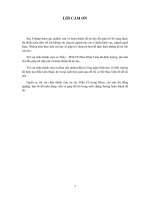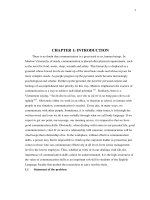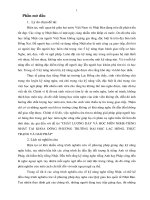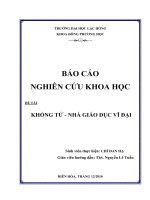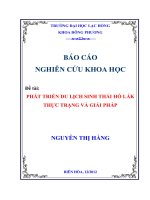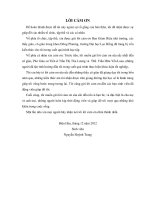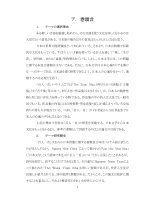Báo cáo nghiên cứu khoa học " Better Breeds of Carp for Small-scale Fish Farmers - MS 5 " docx
Bạn đang xem bản rút gọn của tài liệu. Xem và tải ngay bản đầy đủ của tài liệu tại đây (61.85 KB, 6 trang )
Ministry of Agriculture & Rural Development
CARD Project Progress Report
002/04 VIE: Better Breeds of Carp for
Small-scale Fish Farmers
MS 5: FIRST SIX-MONTHLY REPORT
July 29, 2005
1. Institute Information
Project Name
Better Breeds of Common carp (Cyprinus
carpio L.) for Small-scale Fish Farmers
Vietnamese Institution
Research Institute for Aquaculture No. 1
Vietnamese Project Team Leader
Dr Tuan Anh Pham
Australian Organisation
Deakin University
Australian Personnel
Dr Chris Austin
Date commenced
8 March, 2005
Completion date (original)
30 January 2007
Completion date (revised)
28 February 2007
Reporting period
First Six Monthly
Contact Officer(s)
In Australia: Team Leader
Name:
Dr Chris Austin
Telephone:
08 8946 7276
Position:
Professor/HOS
Fax:
08 8946 6151
Organisation
Charles Darwin University
Email:
In Australia: Administrative contact
Name:
Dr Jenny Carter
Telephone:
08 8946 6708
Position:
Manager Research
Fax:
08 8946 7199
Organisation
Charles Darwin University
Email:
In Vietnam
Name:
Dr Tuan Anh Pham
Telephone:
84 4 8781084
Position:
Deputy Director
Fax:
84 4 8785748
Organisation
Research Institute for Aquaculture No. 1
Email:
Patuan.2006@yahoo.
com
2. Project Abstract
Increased inland fish production is a high priority for the Government of Vietnam
particularly in the context of rural development in relation to food security, poverty
alleviation and income generation. This project aims to assist the continued development of
genetically improved common carp breeds, the effective dissemination of these breeds from
central research institutes to provincial hatcheries for distributions to small scale farmers and
further development of research capacity in genetics in relation to selective breeding and
brood-stock management. Excellent progress has been made with in the first six months of
this project. Almost all inputs have been achieved and all milestones have been met or
exceeded. A questionnaire to investigate and document fish breeding practices and assess
knowledge levels has been developed, tested, refined and ~100 stakeholders interviewed.
Over fifty populations of carp have been sampled from research stations, provincial
hatcheries, private hatcheries farmers and wild populations. Two workshops were conducted
in May, one for hatchery personnel and farmers and one for young scientists. Laboratory
equipment has been purchased and is being used for research and training
3. Executive Summary
Excellent progress has been made with this project. The project commenced 8
th
March, 2005
and almost all inputs have been achieved and all milestones have been met or exceeded that
were planned for the first six months. A questionnaire designed to reveal and document fish
breeding practices and assess knowledge levels among farmers and hatchery personnel has
been developed, tested, refined and ~100 stakeholders interviewed. The data collected will be
analysed and summarised over the next few months. Fifty two populations of common carp
have been sample (by taking fin clips) from research stations, provincial hatcheries, private
hatcheries and from farmers through out Vietnam and will now be subject to DNA
genotyping. Two highly successful workshops were conducted in May, one for young
scientists and one for hatchery personnel and farmers. The first workshop (May 5-9) was
attended by 23 young scientists from 10 research organizations or tertiary institutions. These
included the Research Institutes for Aquaculture No. 1, 2 and 3, Can Tho University, College
of Fisheries, University of Fisheries in Nha Trang, Vinh University, Hue University, Hanoi
Agriculture University, and the Marine Research Institute. The workshop (May 10-15) was
attended by 19 farmers and hatchery personnel from through out the country. Participants
came from the following provinces: Bac Ninh, Vinh Phuc, Hanoi, Thai Nguyen, Yen Bai,
Quang Binh, Binh Dinh, Gia Lai, Nghe An, and Hai Duong A range of reference materials
and manuals to support these workshops were produced. Also, laboratory equipment has
been purchased and is being used.
4. Introduction & Background
The general aim of this project is to identify better breeds of common carp and increase the
utilisation of such fish by small-scale farmers as means of increasing yields and lowering
costs, and thereby contributing significantly to poverty alleviation and income generation for
communities heavily dependent on fish aquaculture for livelihoods and food security.
Common carp was chosen as the target species as it is the most important cultured fish
species in Vietnam (approximately 20,000 metric tons produced per year) with a very large
number of people, including those in low income regions (e.g. highlands) and ethnic
minorities, dependent upon it for food security and income. Further, the Vietnamese
Government has in the past, and continues to invest significant resources into the production
and dissemination of genetically improved breeds of this species, and there is significant
local expertise in the area of genetics and breeding (e.g. staff of the Research Institute for
Aquaculture No. 1).
The specific objectives of this project are to: (1) document current fish breeding and brood-
stock management practices in relation to the selection and maintenance of genetically
improved common carp breeds at the institutional, hatchery (provincial and private) and
small-scale farm levels; to assess knowledge levels relating to fish breeds and selection of
seed stock by small scale farmers; (2) determine genotypic and phenotypic diversity among
common carp genetic resources (breeds), both wild and domesticated, available for
aquaculture within Vietnam and examine the success of dissemination of genetically
improved breeds to small scale farmers; (3) increase success and efficiency of common carp
breeding, broodstock management and seed stock production by small scale farmers and
hatchery personnel; (4) increase capacity of young researchers and technicians to contribute
to research and development in the fields of genetics of broodstock management, molecular
genetics and fish genetic improvement; and (5) To demonstrate to farmers, on farm, the
advantages of using genetically improved breeds of carp.
The approach adopted for this project involves a novel combination of traditional and
modern methods. Thus the understanding of common carp genetic resources in Vietnam and
the success of the dissemination of genetically improved breeds to small-scale farmers will
be based on the use of modern (molecular genetic) and traditional phenotypic
(morphological, pond growth trials) approaches, and through demonstration (by stocking
improved fish breeds into farmers ponds) and by interviewing stakeholders. Also a more ‘de-
centralised’ approach to both understanding carp genetic resources will be taken using
comprehensive geographic sampling of domesticated and wild populations and through
capacity building for provincial hatcheries (via training programs) to enable better brood-
stock management and improve fish breeding.
5. Progress to Date
5.1 Implementation Highlights
The principal achievements to date have been:
(1) the successful implementation of 2 workshops at the Research Institute for
Aquaculture No. 1,
(2) the construction of a questionnaire to determine knowledge levels relating to fish
breeding and genetic improvement and common breeding practises by small scale
fish farmers and hatchery personnel and the interviewing of ~100 farmers and
hatchery personnel ( ahead of schedule), and
(3) sampling of common carp populations throughout Vietnam (also, ahead of schedule)
5.2 Smallholder Benefits
The most direct benefits to small-scale fish farmers to date have been through the workshops
run at the Research Institute for Aquaculture No. 1 for fish farmers, hatchery personnel and
the interviewing of small scale farmers in relation to the documentation of current fish
breeding and brood stock management practices.
5.3 Capacity Building
A contribution to capacity building at the institutional level has been made through the
training programs delivered as part of the first workshop.
5.4 Publicity
None to date.
5.5 Project Management
Management of the project as been effective.
6. Report on Cross-Cutting Issues
6.1 Environment
No issues.
6.2 Gender and Social Issues
Gender balance was appropriate for the first workshop run for young scientists (14:9, female
to male ratio), however the gender balance was significantly skewed in favour of males (2:17
female to male ratio in the workshop for carp farmers and hatchery personnel. While fish
farming and breeding is largely the domain of males an effort will be made to encourage the
participation of a larger proportion of women in the second fish farmer workshop.
7. Implementation & Sustainability Issues
7.1 Issues and Constraints
While the implementation of the project has been highly successful over the first reporting
period an issue was the departure of Associate Professor Austin’s postdoctoral research
fellow, Dr Chris Burridge, a fish geneticist, earlier this year. His absence has been covered
through additional input from Dr Austin and the use of part time staff (Schultz and Baranski).
The major issue that has arisen since the commencement of the project is that Dr Austin has
recently been appointed to the position of Professor and Head of School of the School of
Science and Primary Industries at Charles Darwin University, Darwin, Australia. Dr Austin
will take up this position in November 2005.
7.2 Options
As the resources and expertise available at Charles Darwin University in the fields of
aquaculture and genetics are similar to, or better than those available at the Warrnambool
campus of Deakin University, there should no major issues in having the project transferred
from Deakin University to Charles Darwin University. Letters of support for the transfer of
the project will be obtained from the Research Offices of Deakin University and Charles
Darwin University and forwarded to Hassall & Associates in the near future. Further, Charles
Darwin University will be appointing a Research Fellow in Fish Genetics latter this year.
This person will support Dr Austin’s research program in aquaculture and fish and
invertebrate genetics including this project.
7.3 Sustainability
No major issues other than those indicated above.
8. Next Critical Steps
The next steps are:
(1) Collate and analyse the data from the questionnaire and interviews of small scale fish
farmers and hatchery personnel.
(2) Commence the collection of genetic data (genotyping fish).
(3) Provide high level technical training in Australia for two Vietnamese scientists
There are no major constraints envisaged to project objectives as outlined. Two young
Vietnamese scientists have been identified and letters of invitation have been forwarded
to them.
The only other additional step is to transfer the project from Deakin University to Charles
Darwin University.
9. Conclusion
Progress of this project has been highly satisfactory and all objectives established for the first
6 months have been met of exceeded.
